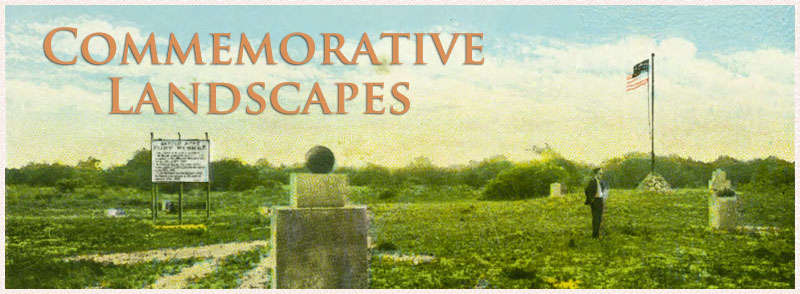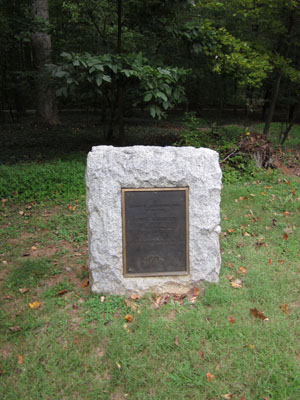
George Washington Plaque, Guilford Courthouse
William Pfohl, Briggs-Shaffner Company, Winston Salem, NC, Builder
A bronze plaque on a stone marker commemorates President George Washington's visit to the area, then known as Martinville, on June 2, 1791. The monument measures 3'1" in height and 3'1" in width.
Images (courtesy of Natasha Smith):
Bronze plaque |
View of the memorial
IN / PATRIOTIC COMMEMORATION / OF THE VISIT / OF / GEORGE WASHINGTON / ON HIS / TOUR OF THE / SOUTHERN STATES / 1791 / MARKED BY THE NORTH CAROLINA / DAUGHTERS OF THE AMERICAN REVOLUTION / 1925
Guilford Courthouse National Military Park
November 10, 1925
36.131830 , -79.846530
View in Geobrowse
Baker, Thomas E. and Michael H. White. The Monuments at Guilford Courthouse National Military Park, North Carolina, (Greensboro, NC: Guilford Courthouse National Military Park, 1991)
Baker, Thomas. "Guilford Courthouse: George Washington’s Visit – June 2, 1791," National Park Service, (accessed February 1, 2012) Link
Farnham, Thomas J. "Washington's Southern Tour," NCpedia.org, 2006 (accessed May 28, 2014) Link
National Park Service, U.S. Department of the Interior. "Inventory Form - Guilford Courthouse National Military Park" in North Carolina National Register of Historic Places, (accessed November 6, 2019) Link
“D.A.R. Members Plant Tree at Battleground,” Greensboro Daily Record (Greensboro, NC), November 11, 1925
“D.A.R. to Honor Washington,” Greensboro Daily Record (Greensboro, NC), November 6, 1925
“Washington’s Southern States Tour,” The Historical Marker Database, HMdb.org, (accessed April 11, 2018) Link
Yes
Granite and bronze
North Carolina Daughters of the American Revolution
In the spring of 1791, President George Washington began his tour of the southern states. Washington decided even before his inauguration to visit every state in the nation in order to gain a better understanding of the condition of the country and the needs of the people. His cross-country journey began in 1789 but, because North Carolina did not ratify the United States Constitution until 1790, his trip to the south was delayed.
Between March and June of 1791, Washington traveled along the eastern seaboard from Maryland to Georgia, and then took a western return route from Georgia to Virginia. During his 1,700-mile tour he sought to emphasize national unity, understand the region's political sentiments, and learn about the southern economy. North Carolina was of particular importance to the tour because of its late ratification and Washington used his stops in the state as an opportunity to reinforce its admittance into the union.
Washington was revered as the father of the nation and, because of his status; his visits to communities across the country were of important historical significance. While in North Carolina Washington met with Governor Alexander Martin at his home in Martinsville near Greensboro and toured the Guilford Courthouse Battleground.
There are numerous markers across North Carolina commemorating President Washington's
tour of the southern states in 1791 to include nine identical bronze plaques placed by the DAR in 1925.
Notable among them are
George Washington Plaque, Hampstead outside Wilmington,
George Washington Plaque, Tarboro,
George Washington Plaque, Salisbury,
and
George Washington Plaque, Greenville.
Other markers made of stone include
George Washington and Henry Clay Marker in Wilmington,
George Washington Boulder in Lexington and
"George Washington Stopped Here" Marker in Arcadia.
This monument is located along a walking trail in Guilford Courthouse National Military Park, on Old Battlefield Road.
The memorial marker stands on grass surrounded by mature trees and bushes.
 Know anything else about this monument that isn't mentioned here? If you have additional information on
this or any other monument in our collection fill out the form at the Contact Us link in the footer. Thank you.
Know anything else about this monument that isn't mentioned here? If you have additional information on
this or any other monument in our collection fill out the form at the Contact Us link in the footer. Thank you.

